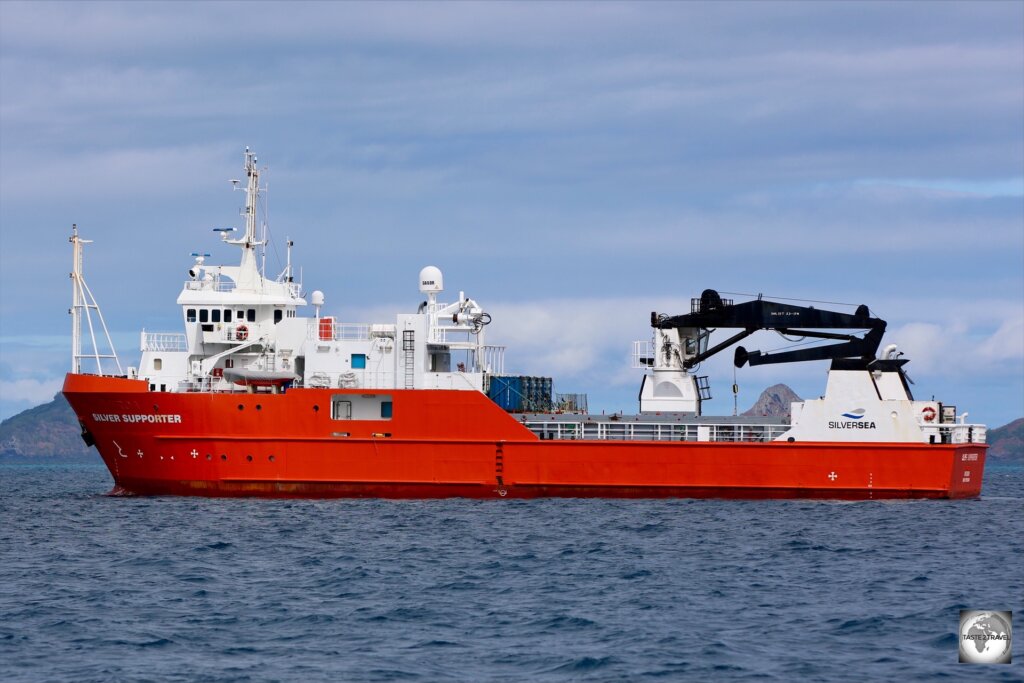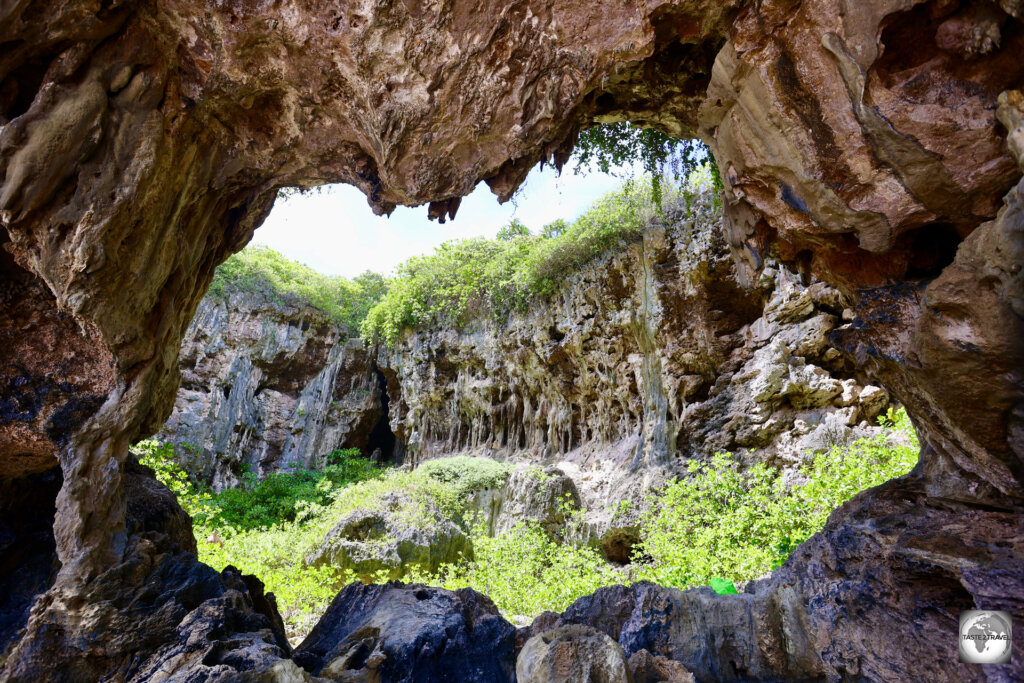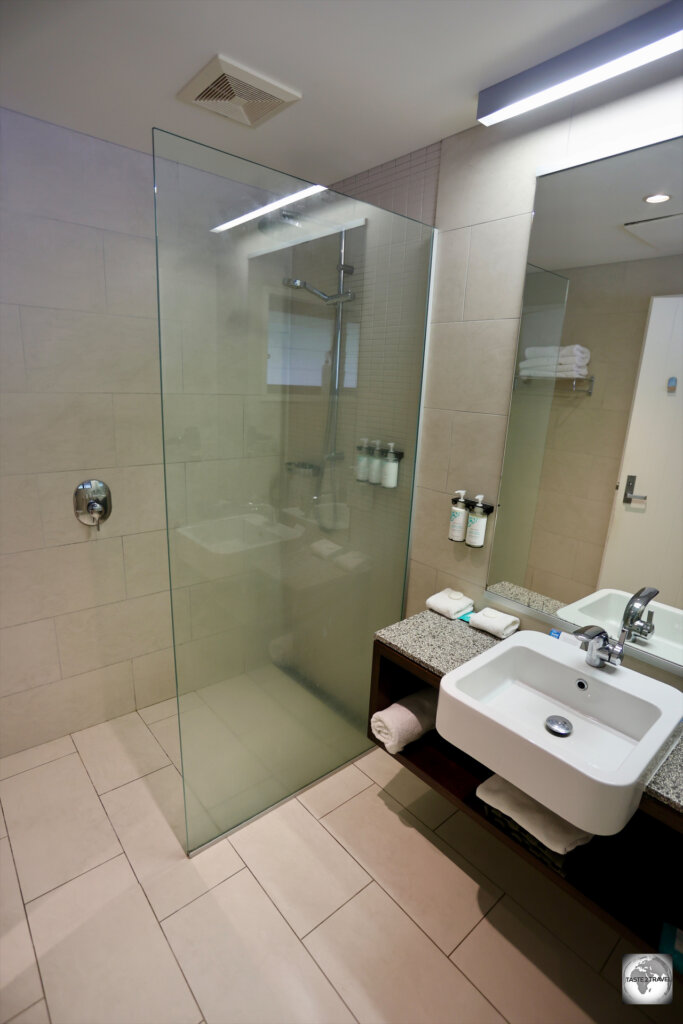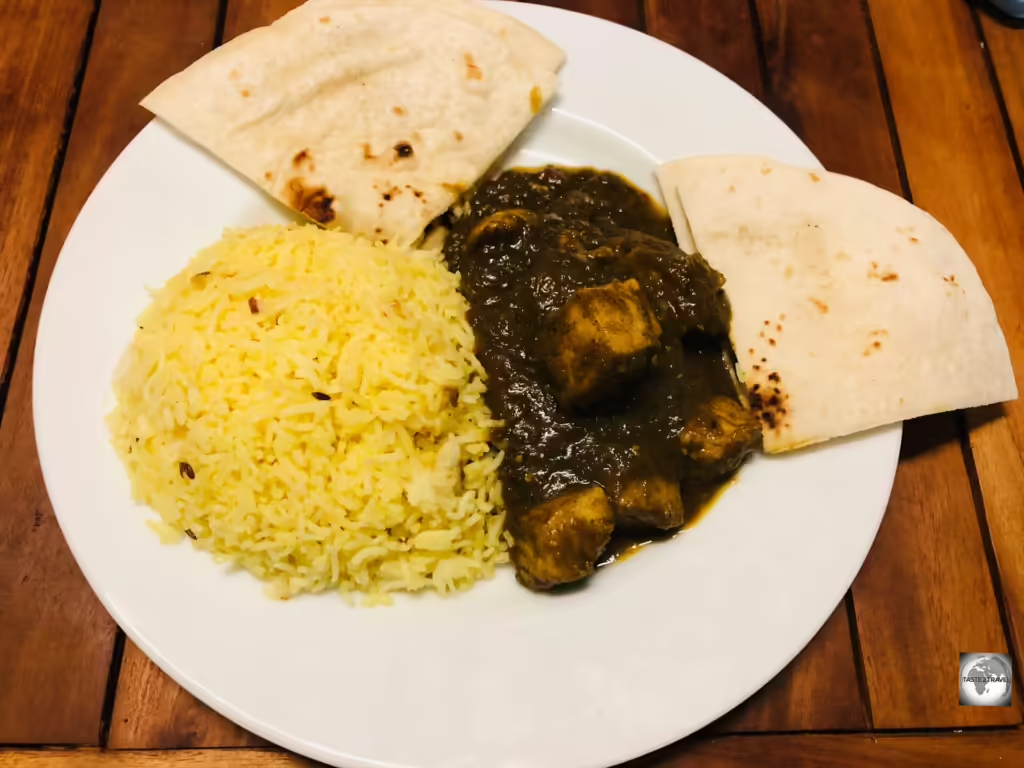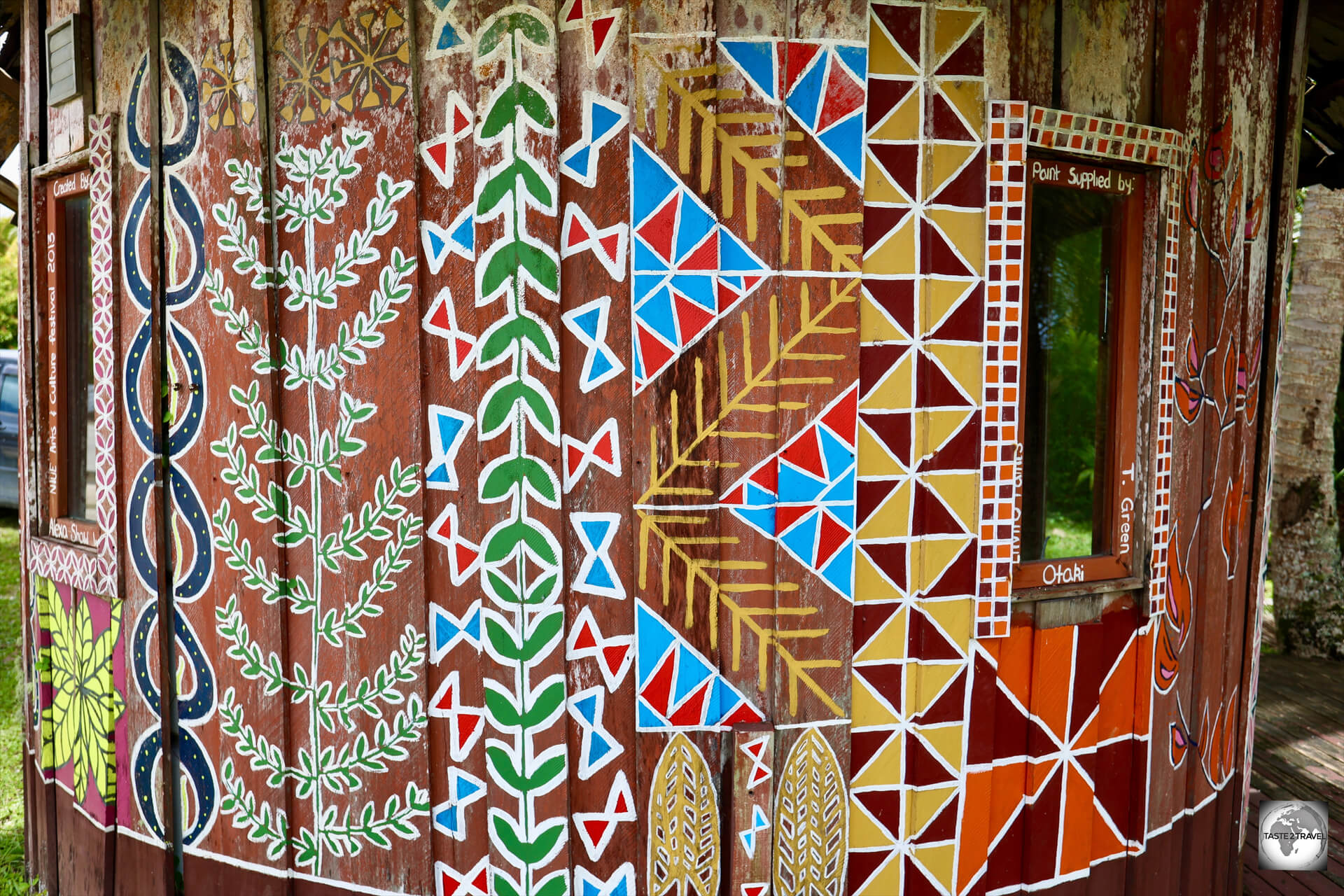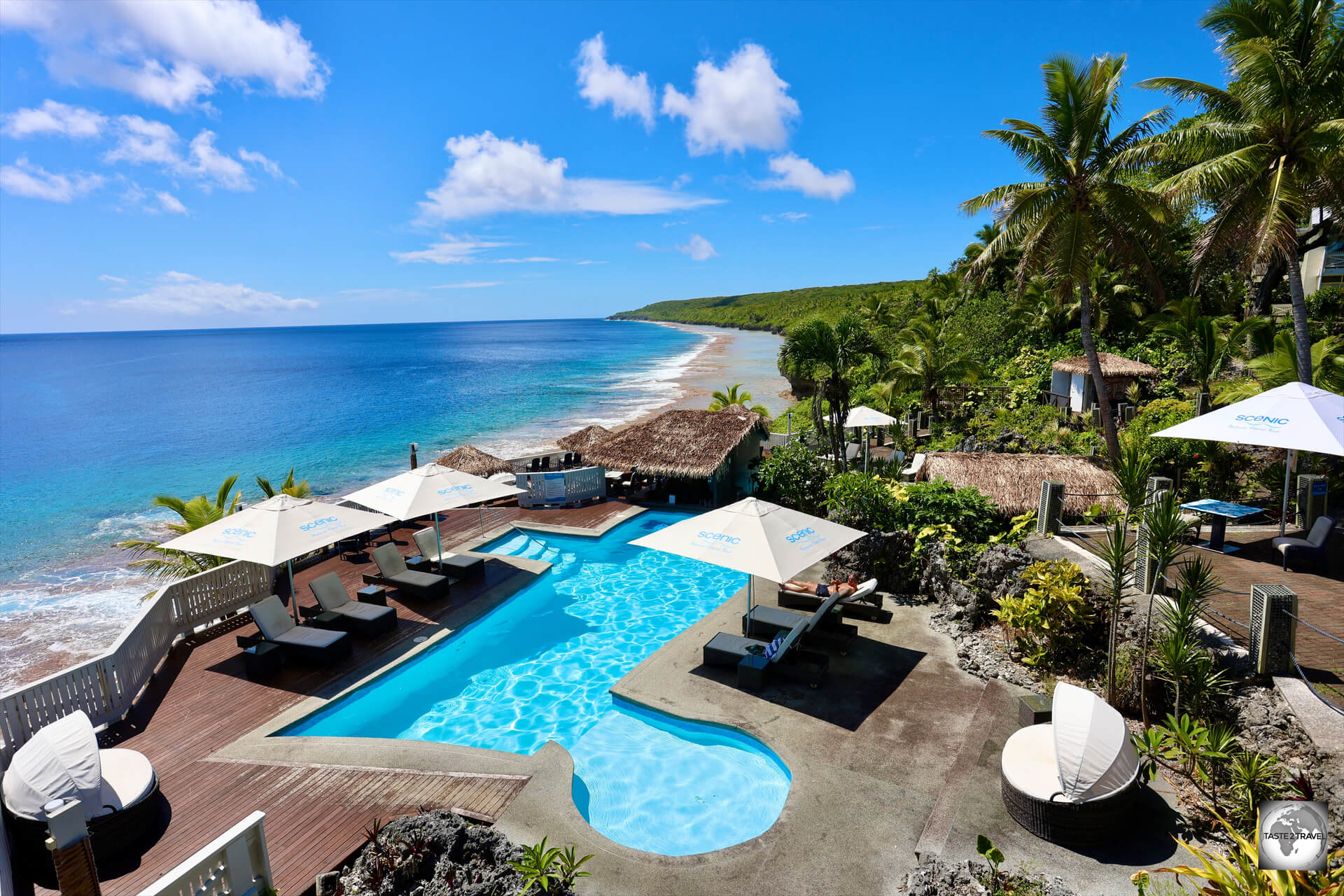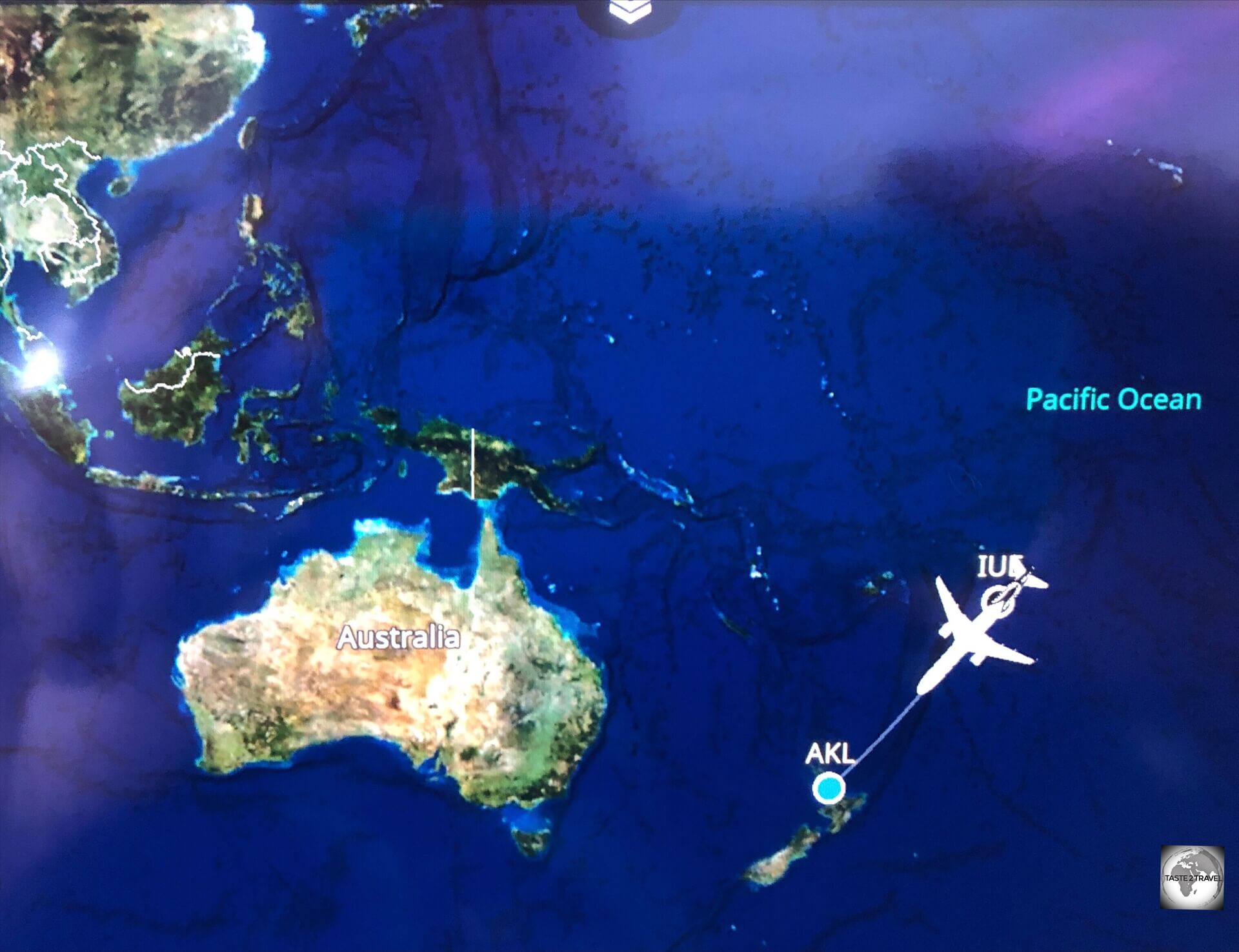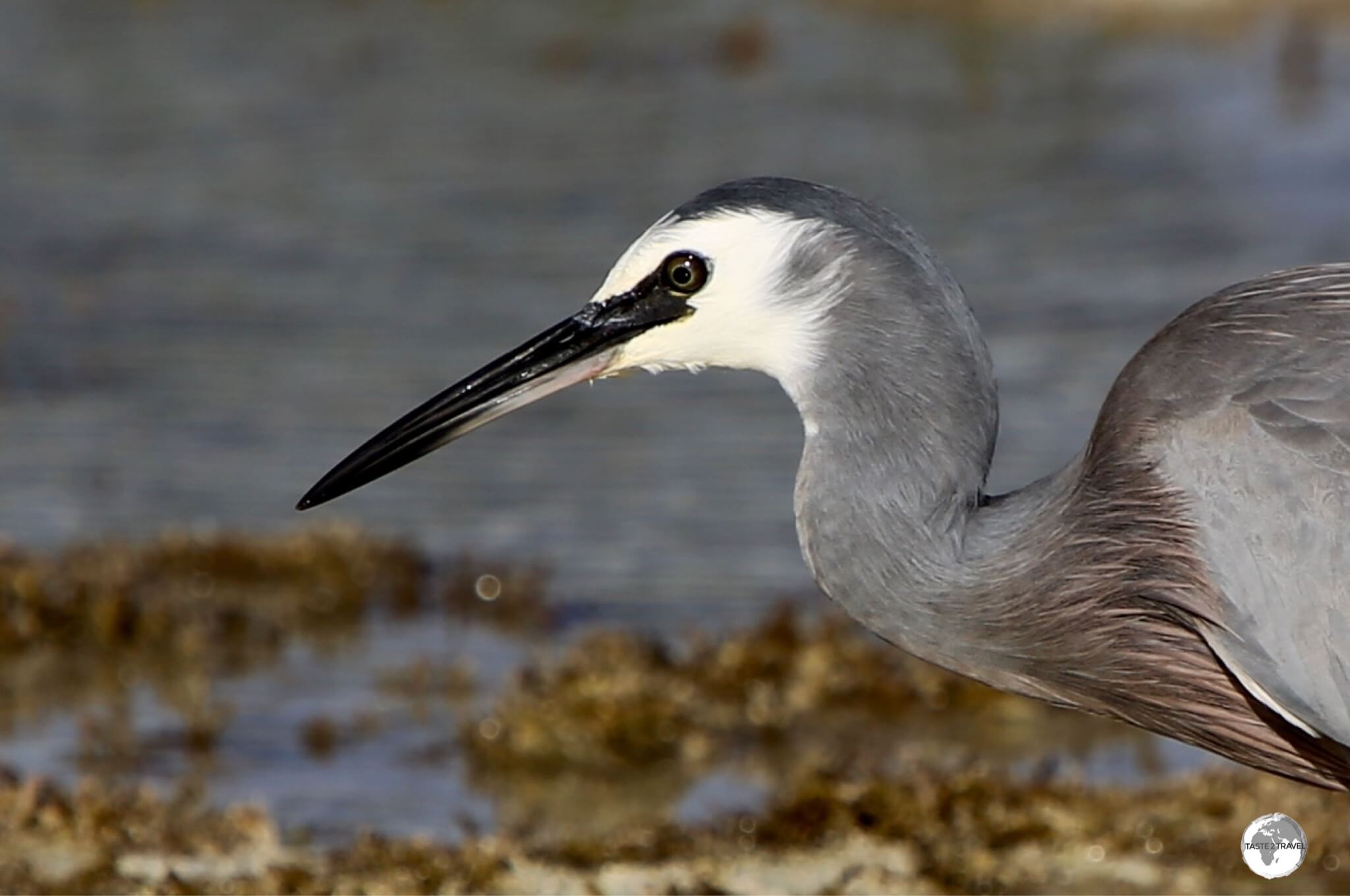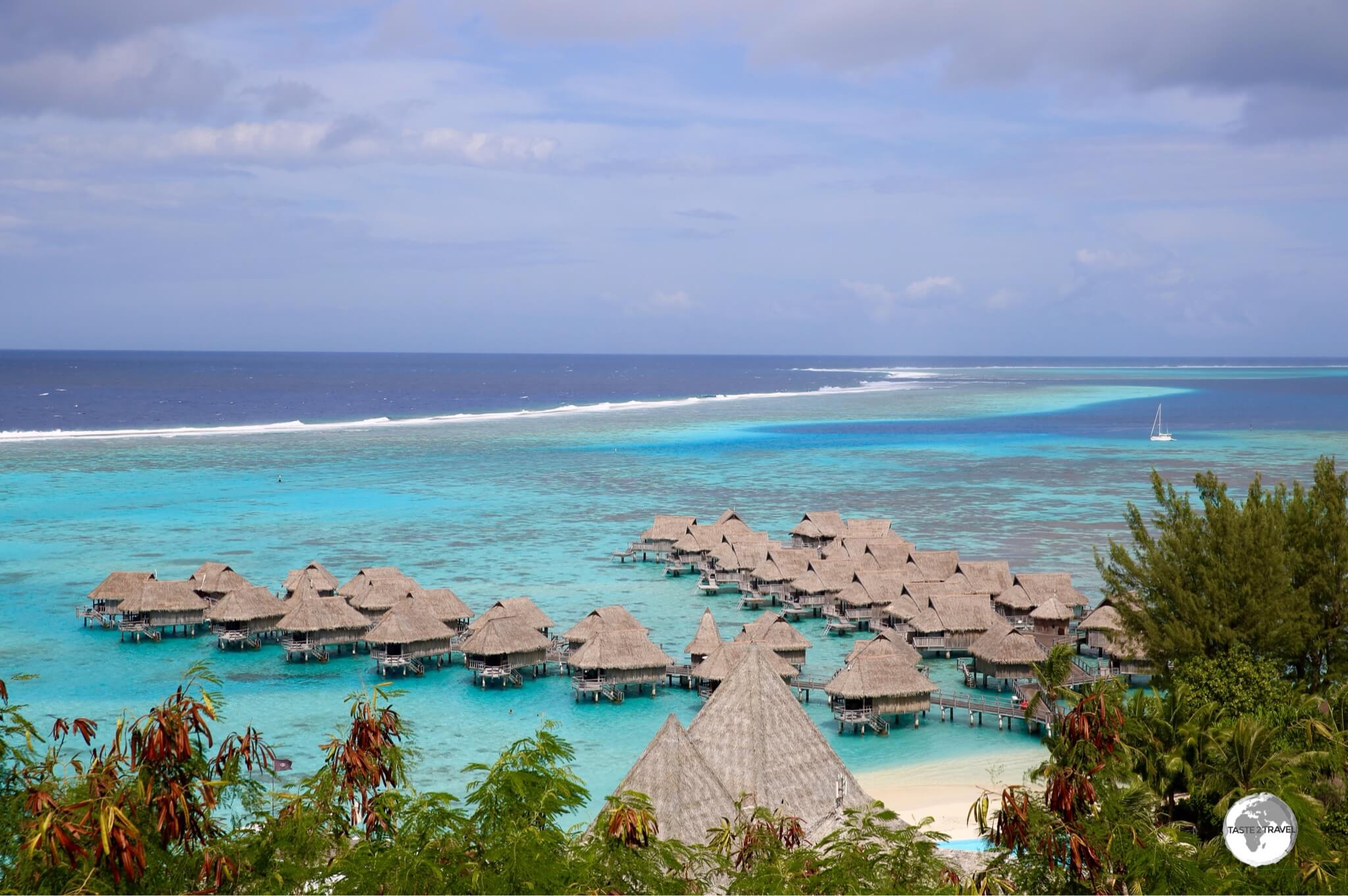Wallis and Futuna Travel Guide
This is a Wallis and Futuna Travel Guide from taste2travel.com
Date Visited: October 2024
Introduction
The remote French territory of Wallis and Futuna lies in a not-so-remote corner of the Pacific Ocean, with tourist hubs such as Fiji just 786 km (488 mi) to the southwest.
Despite being an off-the-radar destination, the French territory of Wallis and Futuna offers an authentic Pacific Island travel experience, well away from the tourist hordes.
With little in the way of tourist facilities and services, no public transport or taxis, visitors are very much left to their own devices, with a rental car being the only way to explore the islands.

Saint Joseph’s church dominates the village of Mala’efo’ou on Wallis Island.
The islands are home to a small community of 11,558 souls (8,333 on Wallis Island and 3,225 on Futuna Island) who live in traditional villages which remain largely undisturbed by the modern world.

Views of two of the many offshore islets, which lie in the lagoon which surrounds Wallis Island.
Villages are dispersed on the islands, mainly on the coast, and the islanders enjoy an unhurried way of life which revolves around church services and lazy Sunday family lunches.
Currently, the only airline which operates flights to Wallis and Futuna, Aircalin, flies twice a week (Saturday and Monday) from their base in Noumea, via Nadi.

A statue of Jesus, bedecked in many leis, in Leava, Futuna Island.
Due to its monopoly operation, which Aircalin jealously guards, airfares are kept high and would discourage all but the keenest of travellers from flying to the islands.
As with other French territories, travel costs on Wallis and Futuna are very high when compared to neighbouring destinations such as Fiji and Samoa.
Wallis and Futuna is not a budget-friendly destination!

A statue of St. Joan of Arc, dressed in a lei holding her flag.
Although a French territory, unlike anywhere else in the Francophone world, Wallis and Futuna are ruled by three kings who have much control over the running of the islands.

A view of the lagoon and offshore islets from Wallis Islands.
The number of French expatriates in Wallis and Futuna has always been small. Of the total resident population on the islands, only a small number are of European descent.
Because of their relative isolation, Wallis and Futuna attracts few tourists. For those who do make the voyage, Wallis and Futuna offers a unique and authentic travel experience.
Location
Wallis, 98600, Wallis and Futuna
Wallis and Futuna is a French overseas collectivity located in the South Pacific Ocean, about two-thirds of the way from Hawaii to New Zealand.
It lies 786 km (488 mi) northeast of Fiji, 446 km (277 mi) west of Samoa, and 961 km (597 mi) southeast of Tuvalu.
This remote French territory consists of three main islands, Wallis, Futuna and Alofi, and a number of smaller islets.

A map of the South Pacific, showing the location of Wallis and Futuna Islands.
The islands are volcanic in origin, with low hills, and fringing reefs.
Wallis Island (Uvea) is the largest and most populous of the islands, located in the northern part of the territory.

Artwork showing a view of two offshore motu’s from Wallis Island.
The island is surrounded by a lagoon and a barrier reef, which makes it ideal for fishing and water activities.
The wide lagoon around Wallis, and its 22 smaller surrounding islets (motu’s) are confined by a large barrier reef and smaller fringing reefs

On final approach to Wallis Island which is surrounded by a fringing reef.
The smaller and more rugged Futuna Island is located about 230 kilometers southwest of Wallis Island. It’s part of a twin-island group with Alofi Island.
The highest point is Mont Puke, also known as Mont Singavi which is located on Futuna Island and rises to a height of 524 metres (1,719 ft).

No shortage of colourful tropical flowers, such as frangipani’s, on Wallis and Futuna.
Alofi Island lies just southeast of Futuna and, due to a lack of fresh water, is home to just one hardy inhabitant.
History
Wallis Island was originally settled 3,400 years ago by Austronesian explorers.
It’s believed the original ancestors of the Polynesians, the Austronesians, left Taiwan 4,000 years ago, stepping from island to island across the Pacific, all the way to Easter Island (click to view my Easter Island Photo Gallery).
Fast forward many millennia to the 15th century, when the powerful Tongan empire extended its influence to Uvea (now Wallis Island), establishing a chiefdom system which remains to this day.

Built around 1450, Talietumu is an ancient Tongan fort and one of the highlights of Wallis Island.
One of the key sites on Wallis Island, Talietumu is an ancient Tongan fort which was built during the Tongan period.
The fort, built around 1450 during the expansion of the Tu’i Tonga Empire, was the last holdout of the Tongans on Uvea until they were defeated.
While the Tongans occupied Uvea, the Samoans settled on Futuna in the 17th century, leading to the formation of the current kingdoms in the 18th century.
In 1767, British navigator, Captain Samuel Wallis, visited Uvea and gave his name to the island.
Although the first European discoveries of the island were made by the Dutch and the British in the 17th and 18th centuries, it was the French who declared a protectorate over the islands in 1842.
In 1959, the inhabitants of the islands voted to become a French overseas territory.
People

Waiting for the flight at Futuna Airport.
Population
The islands of Wallis and Futuna are home to 11,558 souls (8,333 on Wallis Island and 3,225 on Futuna Island). It is a population in decline!
During the 2000’s, the islands witnessed a large exodus of its young working-age population as many left for better work and study opportunities mostly in New Caledonia and France.

The inhabitants of Wallis and Futura are ethnically Polynesian.
The overall population in 2003 was 14,944, and, as of the last census in 2023, is currently at 11,558.
Due to limited economic opportunities, a significant number of Wallisians and Futunans have migrated to New Caledonia, where a large diaspora exists, often sending remittances back to their families on the islands.
Lifestyle
The inhabitants of this remote Pacific paradise live in close-knit communities where family ties and communal responsibilities are highly valued. Extended families often live together, and there is a strong sense of mutual support.
Most of the population lives in rural villages, with subsistence farming, fishing, and small-scale agriculture being common livelihoods. The pace of life is generally slow and community-focused.
The people of Wallis and Futuna are known for their warm hospitality, strong community bonds, and deep respect for their cultural traditions and heritage. Despite the challenges of living in a remote location, they maintain a resilient and vibrant cultural identity.
Polynesian Culture

A painting, in the Mata-Utu post office, depicting a traditional Kava ceremony.
Following centuries of occupation by the Tongans and Samoans, the Wallisians (Uveans) and Futunans, have a rich cultural heritage deeply rooted in Polynesian traditions.
This has been combined with influences from the French colonial history, most notably the introduction of the Catholic religion which is a central part of life on the islands.
The majority of the population is of Polynesian descent, sharing cultural and linguistic ties with other Polynesian groups such as Samoans, Tongans, and Tahitians.
There are two main cultural groups – Wallisians (Uveans) on Wallis Island and Futunans on Futuna and Alofi Islands. While they share similarities, each group has its own distinct language, customs, and identity.
Language
While all inhabitants of Wallis and Futuna speak French, on Wallis Island, the everyday language spoken by the local inhabitants is Wallisian (Uvean), while on Futuna Island, the locals speak Futunan.
Religion

Spectacular churches can be found in most villages throughout Wallis and Futuna.
As for religion, the vast majority of the population practices Roman Catholicism, which plays a central role in the community’s daily life.

A view of the interior of the Chapel of Saint Joan of Arc in Halalo village.
For many locals, each day starts by attending a 5 a.m. mass at their village church. Churches can be found in most villages!

The Cathedral of Our Lady of the Assumption in Mata-Utu.
The influence of the Catholic church is strong, with many cultural and social events centred around religious practices and celebrations.
Monarchy

A view of the royal palace in Mata-Utu, the capital of Wallis Island.
In terms of social structure, society is organised around traditional chieftaincies, with each island having its own hierarchical system.
Chiefs, or “kings,” hold significant influence over local affairs, often working alongside French-appointed administrators.
The original system of monarchy on Uvea (Wallis Island) was established by the Tongans under the Tuʻi Tonga dynasty. This dynasty ruled over Uvea from approximately 1400–1600 (CE).
There are three traditional kingdoms in the territory, all of which have a degree of political power. Those kingdoms include: Alo and Sigave (both on Futuna Island) and Wallis.
Did you know?
Wallis and Futuna is the only French territory ruled by a Monarch!
While France famously abolished its monarchy on the 24th of February 1848, Wallis and Futuna have been allowed to maintain their royal families.
Under a 1961 statute, France agreed to maintain three monarchies (one in Wallis and two in Futuna) in which customary rights exist and co-exist within French law.
The kings are remunerated by the French Government.
Each customary monarchy consists of a king (“Lavelua”), appointed by the royal families, assisted by a prime minister and a ‘chefferie‘, which is comprised of the village chiefs.
The kings are responsible for managing land and familial disputes and for religious and customary ceremonies.
How is the king chosen?
The title is not hereditary, but given to a person chosen from a group of royal families.
The discussions on who to crown can take months or even years.
The secession issue is often fraught, and, in April of 2016, a standoff on Wallis Island made international news headlines due to a disagreement over who should be crowned as the next king.
At the time, the island chiefs named Tominiko Halagahu as king, however, a rival chief council preferred another candidate – Patalione Kanimoa.
In order to stop the coronation of Tominiko Halagahu, supporters of Kanimoa blockaded the royal palace compound in Mata-Utu.
After almost two months of dispute, Kanimoa was officially confirmed by the administrator-superior of the French Republic as king on 3 June 2016, and has been reigning over the kingdom ever since.
Flag

Flag of Wallis and Futuna
The flag of Wallis and Futuna is distinctive and represents the territory’s connection to France as well as its local identity.
The flag combines elements of the French national flag and local symbolism.
The three constituent kingdoms of Wallis and Futuna (Alo, Sigave and Uvea) have separate royal standards.

The flag of Uvea, flying outside the royal palace in Mata’Utu.
The flag’s design features the iconic French Tricolor, or Tricolore, in the upper left corner. The Tricolor consists of three vertical stripes of blue, white, and red.
This represents Wallis and Futuna’s status as a French overseas collectivity.

The constituent flag of the Kingdom of Uvea.
The rest of the flag is a red field, which takes up the majority of the design. On this red background, there is a white cross that is placed toward the right side of the flag.

The French flag, flying alongside the flag of Uvea in Mata’Utu.
This cross is a thin, equal-armed cross, which symbolises Christianity, particularly the Roman Catholic faith, which is predominant in the territory.
Philately

The stamps of Wallis and Futuna are popular among philatelists around the world.
Wallis and Futuna issues its own postage stamps. These stamps often reflect the unique culture, history, and natural beauty of the islands.

The stamps of Wallis and Futuna feature local marine life.
Popular among philatelists worldwide, the stamps of Wallis and Futuna highlight the cultural heritage of the islands, the fauna and flora – especially marine life, historical events, natural landscapes and much more.

The stamps of Wallis and Futuna showcase local culture and traditions.
These stamps are not only functional but also serve as a means of preserving and showcasing the unique identity of Wallis and Futuna to the world. Collectors often value them for their artistic and cultural significance.
Post Office
Stamps, post cards and SIM cards can be purchased from the main post office in Mata-Utu.
Located on the waterfront, across the road from the Royal Palace, the Mata-Utu post office offers philatelic sales (in an adjacent building), along with post cards and SIM cards.

The ‘Service des Postes et des Télécommunications (SPT)’ sign outside the Mata-Utu post office.
As in other French territories, the post office is known as “Service des Postes et des Télécommunications”, which is always abbreviated as SPT.

The post office sells stamps and post cards.
The friendly and helpful staff assisted me with the purchase of stamps and post cards.

Posting my postcards at the post office in Mata-Utu.
Any postal items can be deposited into the post box which is built into the front wall of the post office.
Wallis Island main post office (SPT headquarters) contacts:

The post office on Futuna Island is located in the main town of Leava.
Postal services on Futuna Island are offered by SPT at the main post office in Leava.
Futuna Island Post Office Branch contacts:
- Address: Lieu-dit Faletoa, in Leava (Sigave)
- Telephone: (+681) 72 36 00
- Opening hours: Monday to Thursday 7.30 a.m. – 2.30 p.m.; Friday 7.30 a.m. – 1.30 p.m.
SIM Cards
The post office (SPT) is responsible for the sale of SIM cards and mobile top-ups. The local mobile network is called Manuia (by SPT)
When I enquired about purchasing a SIM card, post office staff quoted a price of XPF 5,000 (US$45.32) which includes XPF 3,000 credit and 10 domestic SMS, valid for 90 days.
Current data package rates are published on the SPT website – https://spt.wf/
I declined the offer and chose instead to use free WiFi at my guest house and at local restaurants such as Beach Club and Maloccino.
Currency

The Pacific Franc is used in the French Pacific territories of New Caledonia, French Polynesia and Wallis and Fortuna.
The official currency of Wallis and Futuna is the CFP franc (Central Pacific Franc), abbreviated as XPF.
The CFP franc is also used in other French overseas collectivities in the Pacific, such as French Polynesia and New Caledonia.

The Pacific Franc is legal tender in French Polynesia, New Caledonia and Wallis and Futuna.
Exchange Rate
- The CFP franc is pegged to the euro (EUR) at a fixed exchange rate of 1 EUR = 119.33 XPF.
- Currently (October 2024), US$1 = 107.25 XPF. (Click to view the current rate.)
Banknotes and Coins
The currency includes both coins and banknotes. Coins come in denominations of 1, 2, 5, 10, 20, 50, and 100 francs, while banknotes are available in denominations of 500, 1,000, 5,000, and 10,000 francs.

The Pacific Franc (CFP) is the official currency of Wallis and Futuna.
The CFP franc is issued by the Institut d’émission d’Outre-Mer (IEOM), which is the central bank responsible for monetary policy in the French Pacific territories.
Banking Services

Banking services on Wallis and Futuna are provided by the Bank of Wallis and Futuna (BWF).
Banking services on Wallis and Futuna are provided by the Bank of Wallis and Futuna (BWF), a subsidiary of BNP Paribas.
The one branch of BWF can be found in the small shopping arcade behind the SEM Supermarket.
Opening Hours: BWF bank is open between 8:00 a.m. and 12:30 p.m., Monday to Friday.

One of two ATMs on Wallis Island can be found at the main post office.
The bank operates two ATMs on Wallis and another on Futuna.
The ATMs on Wallis are located at the main post office in Mata-Utu and at the entrance to the SEM Supermarket complex.
Credit Cards
Credit cards are widely accepted on Wallis and Futuna with cash rarely needed.
Costs

Arriving on a very wet Futuna Island, where a return flight ticket from Wallis costs XPF 29,800 (US$277.85).
Not Cheap!
With extortionate costs for everything, Wallis and Futuna is not a destination for backpacker’s or any traveller who is on a strict budget.
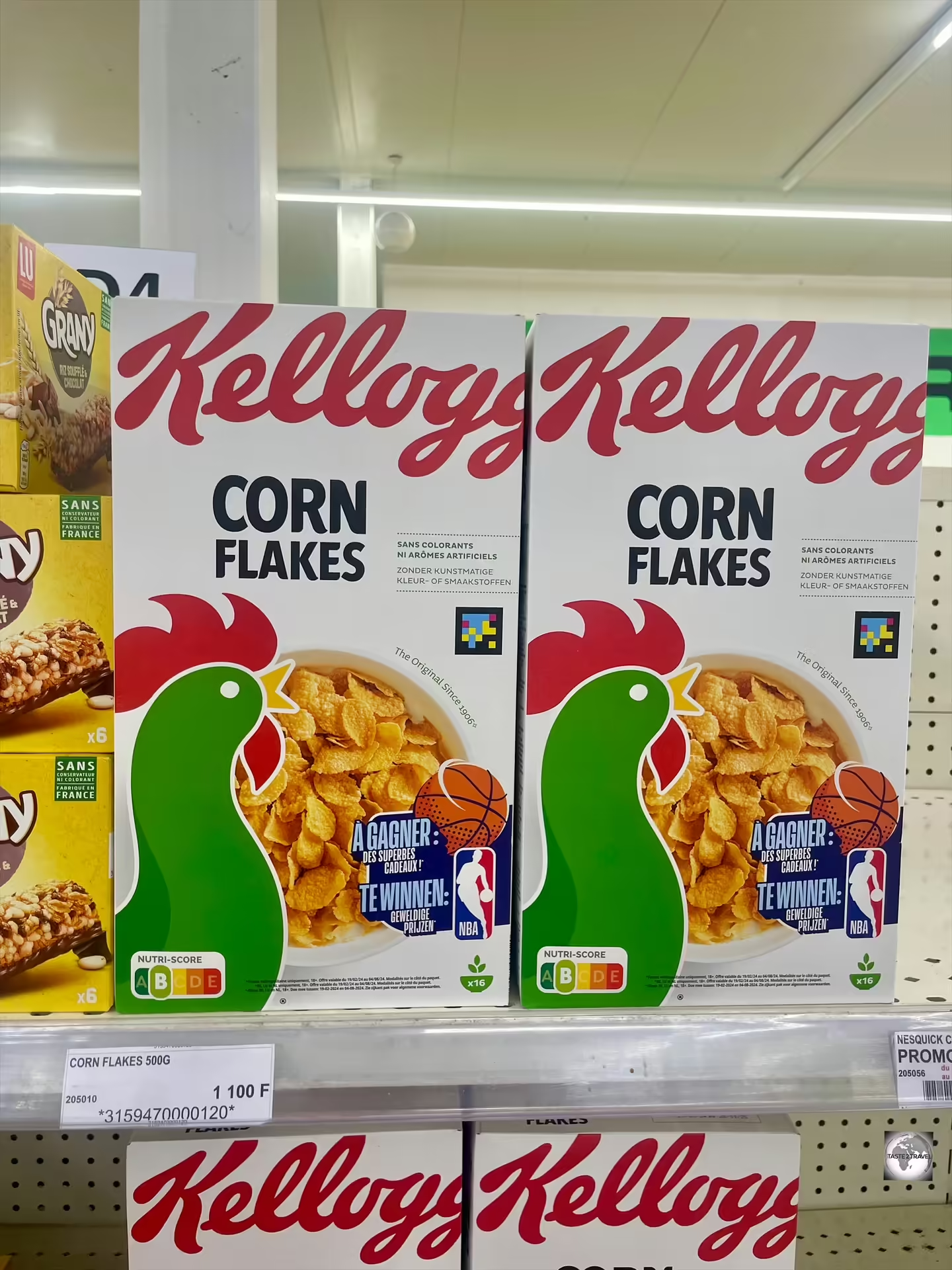
A 500-gram box of Corn Flakes costs XPF 1,100 (US$10.00) at the SEM Supermarket on Wallis.
A typical return flight with Aircalin from Noumea to Wallis will cost around €700 (if you can book in one of the cheaper economy classes) while a return airfare between Wallis and Futuna Island costs XPF 29,800 (US$277.85).
The limited number of hotels offer rooms between XPF 12,000 (US$109) and XPF 18,000 (US$164).
An average meal price in one of the few restaurants costs between XPF 3,000 – 4,000 (US$27.00 – $36).

The dessert menu at Maloccino (XPF1,200 = US$10.88).
Other sample costs:
- Craft beer from Wallis Brewery (0.33 litre bottle): XPF 370 (US$3.38)
- Box of Corn Flakes (500 grams): XCF 1,100 (US$10.00)
- Car hire (per day) from Lausikula Chambre d’Hôtes: XCF 8,000 (US$72.98)
- Litre of fuel: XPF 200 (US$1.82)
- Hamburger and Chips meal at Angélus Garden: XPF 1,500 (US$13.60)
- Grilled Fish meal at Beach Club: XCF 3,000 (US$27.37)
- SIM card from the post office: XPF 5,000 (US$45.32)
SEM Supermarket

SEM Supermarket is the largest supermarket on Wallis Island.
There are few shopping opportunities on Wallis and Futuna.
The largest supermarket in the territory is the SEM supermarket where most produce is imported from France.

A view of SEM Supermarket, the largest on Wallis Island.
Attached to the supermarket is a small shopping arcade where you’ll find the only branch of the Bank of Wallis and Futuna, the Aircalin office, the only museum on Wallis and Futuna, a bakery and several boutiques.
Business Opening Hours
As is typical in the Francophone world, all businesses on Wallis and Futuna, including SEM, close from 12:30 to 14:30 every day for lunch.
Most businesses close at lunchtime on Saturday and remain closed until Monday morning.
Almost nothing is open on Sunday!
Aquatic Sports

Small sail boats available for rent from Vaka Lä.
The turquoise waters of the lagoon which surrounds Wallis Island are inviting and there is no better way to get onto the water than by renting some aquatic equipment from Vaka Lä.

Just some of the equipment available to rent from Vaka Lä.
Located on the waterfront, 300 metres north of the Beach Club restaurant, Vaka Lä rents all sorts of aquatic equipment from surf boards, kayaks, small catamarans, sail boats and much more.

Located on the waterfront, Vaka Lä rents all sorts of aquatic equipment.
Vaka Lä Contacts:

A catamaran rental from Vaka Lä will allow you to explore the lagoon which surrounds Wallis Island.
Sightseeing

This newly published map of Wallis Island is indispensable while exploring the island.
Wallis Island
Wallis Island’s blend of natural wonders, historical sites, and cultural experiences makes it a captivating destination for travellers seeking both relaxation and adventure.
Talietumu Fortress

Talietumu is an ancient Tongan fort on Wallis Island.
Surrounded by lush, tropical vegetation, the ruins of Talietumu Fortress are a highlight of Wallis Island.

Ruins of one of many ancient structures at Talietumu, a former Tongan fort on Wallis Island.
Dating from the 1450s, and known to the Tongans as Kolo Nui, this former Tongan fortress is enclosed by a large basalt-stone wall and includes well-preserved, basalt-stone, ruins.

Dating from the 1450s, the ancient Tongan fortress of Talietumu was the last holdout of the Tongans on Uvea.
The fort is located about 9 km (5.6 mi) southwest of Mata-Utu, northeast of the village of Halalo, and is accessed from a (signposted) side road which leads onto a gravel access track.

A stone circle, with the supporting walls of the man-made platform in the background, at the Tongan fort.
The fort was built on the site of a boundary tri-point, between three ancient kingdoms, which once divided Wallis Island during the Tongan period.

Access to the Tongan fort is through a break in the wall near the car park.
Access into the enclosure is through a break in the wall, near the car park. The site is dominated by a raised, man-made, stone platform called Talietumu, which served as a Marae, i.e. a sacred place.

A view of the man-made stone platform, known as Talietumu.
The large trees which provide shade on the upper platform are covered in wild orchid plants. Unfortunately, no orchids were flowering at the time of my visit.

From the main platform, a couple of steps leads to an upper platform which is completely covered by thick grass.
From the main platform, a short flight of steps leads up to a higher platform which is completely covered in grass.
A view of the supporting walls, which support the man-made stone platform at the Tongan fort complex.
I visited the site twice and each time I was the only visitor.

Ruins of a former structure at the Tongan fort.
Much of the outer areas of the site remain untouched, buried beneath lush vegetation.

A stone wall disappears beneath dense forest vegetation.
Untouched, and devoid of visitors, there is a special energy which can be felt here.
The Tongan fort is an interesting place to visit and should be a candidate site for the UNESCO World Heritage list.
Lake Lalolalo

Dramatic and eerie, Lake Lalolalo is the largest of several, perfectly round craters lakes which can be found on this former volcanic island.
Lake Lalolalo is the largest of several craters lakes which can be found on the once volcanic Wallis Island.
This perfectly round, isolated, and somewhat eerie lake, is surrounded by lush, tropical jungle with a protective wall of sheer, 30m (98ft) high, cliffs which plunge into the murky depths ensuring no one can get too close.
Reaching a depth of 80-metres (262 feet), scuba divers have found a 2-km long underwater tunnel which runs to the west of the lake. Where the tunnel leads no one is certain with further exploration required.

Lake Lalolalo is completely surrounded by sheer red cliffs.
Protected by its all-encompassing cliffs, the lake is a magnet for birds with flying foxes, terns, brown noddies and other birds constantly wheeling overhead.
At the end of World War II, the U.S. military dumped surplus equipment into the lake.
The lake is located north of Lausikula village along a gravel section of route RT1. A sign posted view point for the lake is located on the right-hand side of the road.
Lake Lanutavake

The emerald-green, Lake Lanutavake is the 2nd largest crater lake on Wallis Island.
At about half the diameter of Lake Lalolalo, Lake Lanutavake is the 2nd largest crater lake on Wallis Island.
Located northeast of Fineveke village, this emerald-green, 24-metre-deep (78 ft), fresh water lake is completely surrounded by lush vegetation.
While there is no view point, you can easily photograph the lake from the road.
Like Lake Lalolalo, it is rumoured that the US military dumped equipment in the lake at the end of World War II.
Churches

The calm and peaceful, Chapel of Saint John the Baptist, is located in the east coast village of Falaleu.
As you drive around Wallis and Futuna, it’s hard not to notice the many spectacular churches which can be found in every village on the islands.
The French introduced religion to the islands with the first missionaries arriving in 1837. By 1842, Wallis had completely adopted Catholicism, and by 1846, Futuna followed suit.
Each village in the territory is dominated by an imposing, solid, towering church, most of which have been built from black basalt stone with white limestone mortar.
While Wallisian houses are generally, single-level, modest structures, the churches by contrast are multi-level design extravaganzas with each community seeming to compete with the next for the funkiest church design.
Almost all of the population are practicing Roman Catholics and the presence of the church is felt in every aspect of life. Many Wallisians start each day by attending a 5 a.m. morning mass.
The church plays a central role in education, health care, community activities, social services, and in politics.
Cathedral of Our Lady of the Assumption

The Cathedral of Our Lady of the Assumption in Mata-Utu.
Sitting alongside the Royal Palace in Mata-Utu, construction work on the Cathedral of Our Lady of the Assumption lasted from 1952 to 1959.

A view of the interior of the Cathedral of Our Lady of the Assumption in Mata-Utu.
The church features two towers, with a clock installed in the right-hand tower. Between the towers, the royal insignia of Wallis, a Maltese cross, is installed.
Church of the Sacred Heart

The Church of the Sacred Heart is located in the village of Tepa.

Detail of the basalt-stone brickwork with white limestone mortar at the Church of the Sacred Heart.

Detail of one of the doorways at the Church of the Sacred Heart.

Cemetery at the Church of the Sacred Heart.

A statue of Jesus, inside the Church of the Sacred Heart, is bedecked in many colourful leis.
Over the centuries, the Wallisians have combined Catholic and Polynesian religious beliefs, including dressing Jesus, and the saints, in traditional leis.
Saint Joseph’s Church

A view of Saint Joseph’s Church which dominates the southern village of Mala’efo’ou.
The very first place of Christian worship in Wallis dates back to 1840 and was dedicated to St. Joseph.

A view of the interior of Saint Joseph’s Church.
Eager to have their own stone church, parishioners spent 10 years constructing a beautiful house of worship which overlooks the south coast of Wallis in the village of Mala’efo’ou.
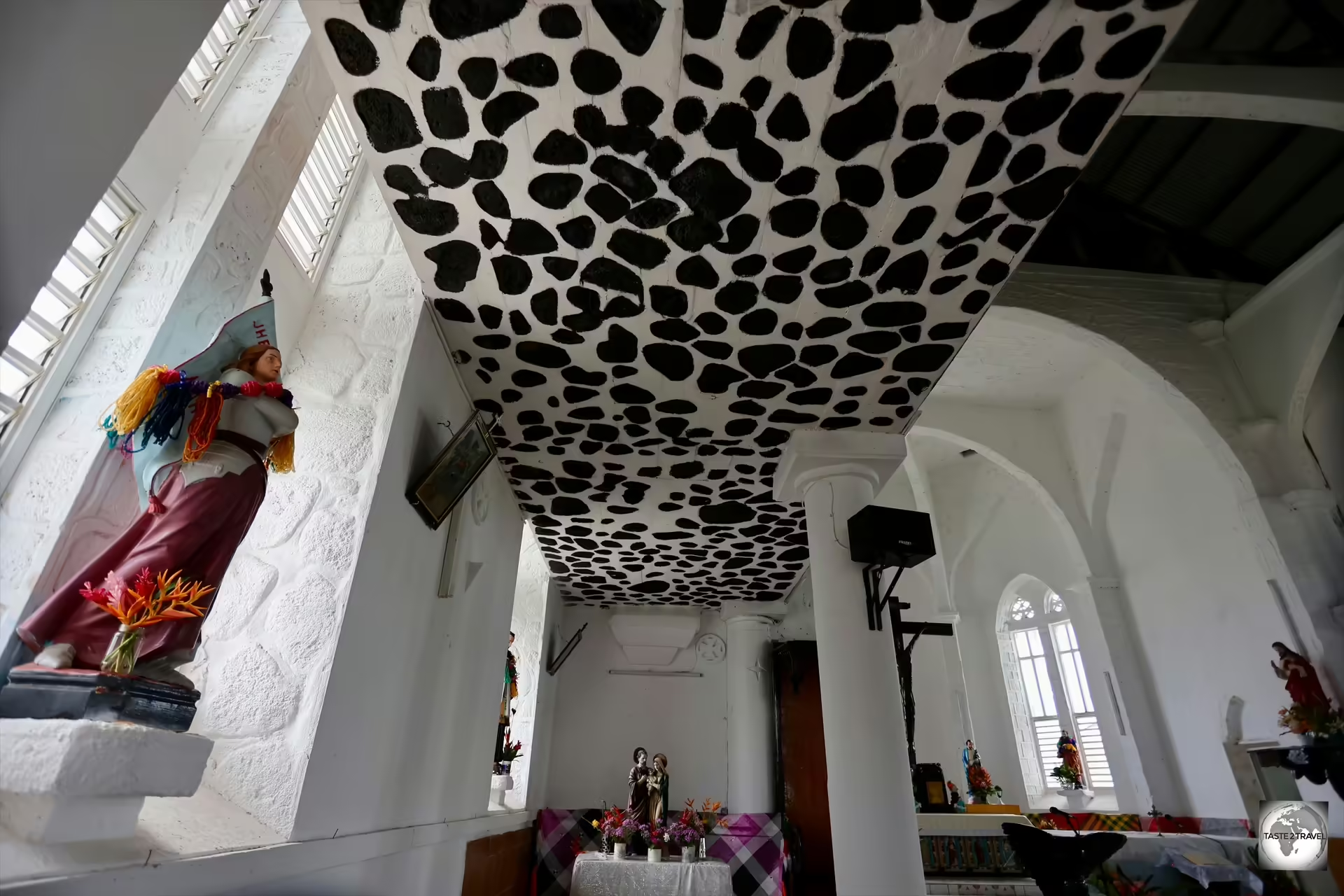
A view of the interior of Saint Joseph’s Church.
Saint Joseph’s Church was opened in 1869.
Chapel of Saint Bernadette

A view of the enormous interior of the Chapel of Saint Bernadette, Lausikula.
A recent addition to the collection of churches on Wallis, the totally oversized Chapel of Saint Bernadette was built following the destruction of the original, smaller, chapel during cyclone Evan which hit the island in December of 2012.

Described as totally ostentatious, the oversized Chapel of Saint Bernadette overlooks the coast in the tiny village of Lausikula.
The chapel overlooks the south-west coast in the tiny settlement of Lausikula.
This overbearing edifice was built at the urging of the local parish priest and consecrated in 2014.
Church of Saints Peter and Paul

The Church of Saints Peter and Paul overlooks the sea in the east coast village of Vaitupu.
Looking more like a Chinese pagoda, the Church of Saints Peter and Paul overlooks the sea in the sleepy east coast village of Vaitupu.

Traditional Wallisian artwork inside the Church of Saints Peter and Paul.
The Hihifo parish church was initially built in the village of Vailila and later transported to its current location in Vaitupu in October 1848.
Construction work of the present church lasted from 1865 to 1866.
Chapel of Saint Joan of Arc
A view of the Chapel of Saint Joan of Arc, Halalo village.
Dominating the tiny south coast village of Halalo, the Chapel of Saint Joan of Arc features a striking interior with the ceiling lined with panels featuring traditional Polynesian designs.

A view of the interior of the Chapel of Saint Joan of Arc, Halalo village.

Always seen holding a white flag, St. Joan of Arc, the patroness of soldiers and of France, dressed in a traditional lei.
Wallis Museum

The single-room Wallis Museum is located inside the shopping arcade behind the SEM Supermarket.
The only museum on Wallis and Futuna, the one-room Wallis Museum is located inside the shopping arcade behind the SEM Supermarket.
The museum, which is always closed, can be visited by contacting Christophe Laurent at Wallis Voyages in Mata-Utu.
Christophe normally conducts tours every Thursday afternoon after he finishes work at the travel agency.
Contact details for Christophe:
Entrance fee for the museum is XPF 1,000.
Futuna Island

Flying from Wallis Island to Futuna Island.
Located 260 km (160 mi) south-west of Wallis Island (halfway between Wallis and Fiji), Futuna Island, and the (almost) uninhabited Alofi Island, form the Hoorn Islands.
This remote archipelago was named by the Dutch navigators Willem Schouten and Jacob Le Maire, who, in 1616, became the first Europeans to visit the islands.
They named it after the Dutch city of Hoorn, from which their expedition had started.
The Hoorn Islands are separated from Wallis Island to the north by the Vitiaz Trench, which reaches a depth of 4,500 metres (14,763 ft).
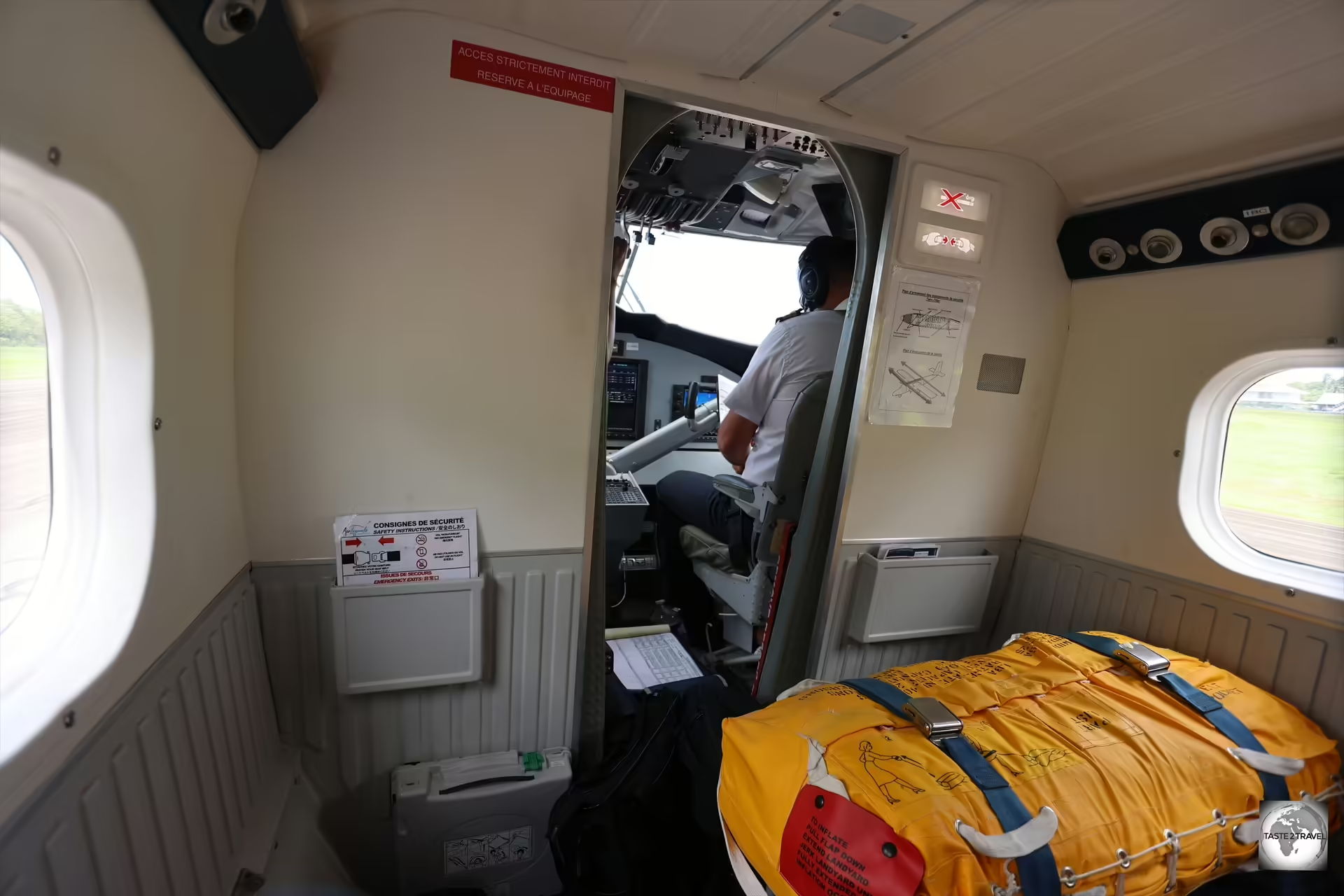
The first row of seats on the Wallis to Futuna flight have been replaced by a life raft, in case the plane has to ditch at sea.
It’s a good thing that the small twin prop plane which connects the two islands has a full-size life raft installed in the first row of the cabin.
In terms of size, at 83 km2 (32 sq mi) in area, Futuna is slightly smaller than Wallis which is 100 km2 (39 sq mi).

A view of the populated, narrow coastal strip and the uninhabited, mountainous, interior of Futuna.
Unlike Wallis, the interior of Futuna is almost vertical and totally uninhabited. Covered in lush tropical jungle, it is the domain of nesting sea birds such as tern’s, brown noddy’s, frigate and tropic birds.
The highest point on Futuna is Mont Puke, which is 524 metres (1,719 ft) above sea level.

Much of the vegetation on Futuna Island is covered by Mikania micrantha, an invasive and pervasive vine which was deliberately introduced by the U.S. Military during WWII.
Much of the vegetation on Futuna is covered by a dense canopy of Mikania micrantha, an invasive and pervasive vine which was deliberately (and recklessly) introduced to both Futuna and Wallis by the U.S. Military during WWII as a form of camouflage for their equipment.
Today, the vine is out of control!

The capital of Futuna is the tiny settlement of Leava.
The population of Futuna is 3,225 with everyone living along the narrow coastal strip.
The capital of Futuna is the tiny settlement of Leava.

Leava chapel serves the small community of Leava, the capital of Futuna Island.
Opposite Leava chapel, lies a memorial to Saint Pierre Chanel, who was a Catholic priest, missionary, and martyr.

A memorial to St. Pierre Chanel, a Catholic priest, missionary, and martyr.
Chanel arrived on Futuna in November 1837 and was clubbed to death in April 1841 at the instigation of a chief upset because his son converted to Catholicism.
Church of Saint Joseph

A view of the Church of Saint Joseph which dominates the village of Nuku.
Located in the coastal village of Nuku, in the constituency of Sigave, the Church of Saint Joseph is where the king of Sigave attends mass.

The royal throne, which is used by the King of Sigave whenever he attends service at St. Joseph’s church in Nuku.
The king’s ornate, wooden throne can be seen in the front row of the church.

A view of the interior of the Church of Saint Joseph, Nuku.
The King of Sigave (titled as Tu`i Sigave) is the ruler of the polity of Sigave, one of the two chiefdoms located on Futuna.
Sigave encompasses the western part of the island.

Mary and Jesus, both wearing leis, on the altar of St. Joseph’s church.
At the altar, both Mary and Jesus can be seen, adorned in traditional leis.

One of the many fale fono – traditional meeting houses – on Futuna Island.
While there are many churches on Futuna, there are even more ‘fale fono‘ – traditional meeting houses, a place where elders gather to discuss matters of importance, much like their forebears did.

A view of a traditional meeting house.
Accommodation
Wallis Island
There are very few accommodation options on Wallis Island and most of the properties cannot be booked online nor do they respond to email enquiries, or answer the telephone, which makes it very difficult to book a room.
The best option is to book one of the two Airbnb properties, which allows you to book online, pay in advance and to communicate with your host online.
There are four accommodation options on Wallis Island and two on Futuna Island. All are covered in this section.
Lausikula Chambre d’Hôtes

Lausikula Chambre d’Hôtes, my homestay on Wallis Island, which I booked online via Airbnb.
Using Airbnb, I booked a room in Lausikula Chambre d’Hôtes – a family run guesthouse which is located in the seaside village of Lausikula, on the remote south-west coast of Wallis Island.

My room at Lausikula Chambre d’Hôtes on Wallis Island.
Rooms
Operated by Manuel Avilez, a Spanish/ French expat who has lived on Wallis Island since 2003, the guesthouse consists of 4 large rooms, all with private bathrooms.

My spacious bathroom at Lausikula Chambre d’Hôtes.
Although the rooms are old and tired, they are spacious and comfortable and cost XPF 12,000 (US$109) per night.
Meals

Breakfast, served by Manuel at Lausikula Chambre d’Hôtes, included Wallis Island honey – some of the purest honey in the world.
- Breakfast, which consists of fresh baguettes, jam and local honey (truly delicious!) is included in the room rate.
- Dinner, which is always a 2-course (main and dessert) gourmet affair costs XPF 4,000 (US$36.37).
I highly recommend the dinners served by Manuel, which were comparable to meals served in the two best restaurants in town.

The living room at Lausikula Chambre d’Hôtes on Wallis Island.
If you wish to eat out, the only restaurants are in Mata’Utu, which is a 20-minute drive.
It should be noted that at night, there is no street lighting on Wallis and no street signs anywhere! If venturing out, you must be confident with the directions back to the guesthouse!
Self-Catering
Manuel has no problem with guests using his fully equipped kitchen, which allows guests to self-cater.
Airport Transfers
Manuel offers airport transfers at XPF 1000 (US$9.00) which is totally reasonable considering the airport is at the opposite end of the island from his guesthouse.
Rental Cars

I rented this Toyota Hilux from Manuel for XPF 8,000 per day.
Due to the remote location of the guesthouse, you will need to hire a rental car.
Manuel offers several manual cars (not in the best condition but perfectly drivable) for XPF 8,000 (US$72.74) per day.
Fuel on the island costs XPF 200 (US$1.82) per litre.
A half tank of fuel at the end of my week-long stay cost XPF 9,000 (US$81.84).
Contact details for Manuel:
The best way to contact Manuel is by WhatsApp messenger.
Hotel Lomipeau

Rooms at the Hotel Lomipeau overlook the swimming pool – the only pool on the island.
Despite being the principal hotel on Wallis Island, you should not expect any response to any accommodation enquiries from the (seemingly) invisible staff at Hotel Lomipeau.
When I was first planning my trip to Wallis, I tried to contact the hotel using email, telephone and even Instagram message. I never received any response from the hotel.

The view of Wallis Island from the terrace of the Hotel Lomipeau.
When I was on the island, I visited the hotel, which is located in the heart of Mata-Utu, and found no one in attendance.
The reception door was open, but the lights were off and there were no staff to be found anywhere. I was assured by locals that the hotel is open and functioning.

Hotel Lomipeau is located in the heart of Mata-Utu, the capital of Wallis Island.
Rooms
If you can manage to make a reservation, the hotel offers 10 rooms with room rates being:
- Single Room: XPF 18,000 (US$164)
- Double Room: XPF 21,000 (US$191)
- Twin Room: XPF 21,000 (US$191)
Room rates include breakfast!
The hotel boasts the only swimming pool on the island.
Hotel Lomipeau Contact Details:
Hotel Moana Hou

Located on the waterfront, Hotel Moana Hou offers a variety of rooms.
Located directly on the waterfront, below the Hotel Lomipeau, the Hotel Moana Hou offers 22 rooms, 7 studios and 3 bungalows.

Artwork, on the wall of the restaurant at the Hotel Moana Hou.
The hotel is located 400 metres from Beach Club (see the ‘Eating Out‘ section below) and 1.5 km from Mata-Utu Cathedral and the Royal Palace.
Room Rates
Room rates at the Hotel Moana Hou are:
- Single room: XPF 12,500 (US$113.66)
- Double room: XPF 15,500 (US$140.94)
- Family room: XPF 15,500 (US$140.94)
- Suite: XPF 20,000 (US$181.86)
Meals

The restaurant at Hotel Moana Hou on Wallis Island.
Hotel Moana Hou offers a restaurant service with breakfast included in the nightly rate.
Lunch and dinner are also available.
Hotel Moana Hou Contact Details:
Manager: Madame Malia Kulikovi
Telephone: (+681) 72 21 35
Email: moana-hou@mail.wf
Facebook: Hôtel Moana Hou
Hotel Ulukula

Located a short walk inland from Mata-Utu, Hotel Ulukula offers 26 rooms.
Located a short distance inland from Mata-Utu, Hotel Ulukula resembles a roadside motel with guests parking their rental cars outside their rooms.

The reception area at Hotel Ulukula on Wallis Island.
This is a clean and functional property which is centrally located.
Rooms
Hotel Ulukula offers 21 rooms plus 5 studio apartments.
Nightly room rates, which include breakfast, are:
- Studio/ room for 1 person: XPF 9,000 (US$81.84)
- Studio/ room for 2 persons: XPF 13,000 (US$118.21)
- Studio/ room for 3 persons: XPF 18,000 (US$163.67)
- Studio/ room for 4 persons: XPF 19,000 (US$172.77)
Hotel Ulukula Contacts:
Futuna Island
There are two accommodation options on Futuna Island and they can be fully booked. It’s best to check room availability before booking flights to Futuna.
Hotel FiaFia

Hotel FiaFia is one of two hotels on Futuna Island.
Like everything on Futuna Island, Hotel Fiafia is located on the narrow coastal strip, in the village of Nuku, which is a five minutes’ drive from the island’s capital – Leava.
Rooms

A view of my room at Hotel FiaFia on Futuna Island.
The hotel offers 9 rooms which consist of 2 single rooms, 4 double rooms (with a balcony) and 3 suites.
At the time of my visit, the hotel was booked out by a team of visiting French marine biologists who were on the island conducting underwater surveys. As part of their job, they were paid to scuba dive each day in the waters surrounding this paradise island.

Rooms at Hotel FiaFia include a fridge, TV and microwave.
I was able to secure one of their double rooms for just one night.
A very average breakfast is included in the room rate. Breakfast consisted of jam and dried crackers (even though fresh baguettes are available on the island).
Rooms rates at Hotel Fiafia are:
- Single room: XPF 9,000 (US$81.84)
- Double room with balcony and a view of the sea: XPF 12,000 (US$109.12)
- Suite: XPF 14,000 (US$127.30)
Airport Transfers
Hotel Fiafia offers airport transfers at XPF 3000 one way (US$27.00) which is expensive considering the airport is just 11km from the hotel.
Meals
With just one snack shop on Futuna, which operates on a very part time basis, most guests eat at the hotel restaurant, where a 2-course meal (main and dessert) costs XPF 3,500 (US$31.83).
The hotel offers a very good lunch and dinner at the same rate.
Hotel Fiafia Contacts:
- Manager: Monsieur Tortey Patrick
- Main Contact: Damien (the son of Tortey Patrick)
- Telephone: (+681) 72 32 45
- Email: hotel_fiafia@yahoo.fr
Hotel de Somalama Park
One other option on Futuna Island is the more distant Hotel de Somalama.
Located in the seaside village of Toloke, this family-run hotel offers 8 rooms.
- Single occupancy: XPF 9,000
- Double occupancy: XPF 12,000
- Triple occupancy: XPF 15,000
Meals
Lunch and dinner are available at XPF 1,500 (US$13.64)
Hotel de Somalama Park Contacts:
Eating Out

A perfect Tuna Tataki, served at Maloccino restaurant.
The cuisine of Wallis and Futuna combines French and local cooking traditions, with one of my favourite meals being local tuna tataki as a main course, finished with a Café gourmand for dessert.

A classic French dessert served with a local twist – a divine Café gourmand, with homemade mango ice cream, served at Beach Club.
Wallis Island
Apart from the excellent meals served by Manuel at my homestay on Wallis, there are a small number of restaurants on Wallis Island.
All restaurants are listed on the Eating Out page of the Wallis and Futuna Tourism website.
Maloccino

Located in the heart of Mata-Utu, Maloccino offers fantastic local and international cuisine.
If I had to pick one favourite restaurant on Wallis, it would have to be Maloccino.
The restaurant offers a selection of local and international dishes with my favourite being the amazingly fresh Tuna tataki (pictured above).
Set in a garden, opposite the hospital, the menu at Maloccino features duck, beef, fish and much more.
The desserts are superb, with the creamy and smooth Mousse au Chocolat being a favourite.
Opening Hours:
- Monday to Saturday: 8 a.m. to 3 p.m.
- Friday and Saturday: 7 p.m. to 10 p.m.
Beach Club

Located directly on the waterfront, Beach Club offers a chilled ambiance with excellent food and drinks.
Despite its name, there is no beach to be found at the Beach Club.
However, for both location and value, it’s hard to beat this seaside chill-out zone which is both a bar and restaurant.

The waterfront wooden dining deck at Beach Club is kept cool by a constant sea breeze.
The popular Beach Club is truly all things to all people, offering a chillout lounge, bar and restaurant, all of which is kept chilled by a constant sea breeze.

The view from the deck at Beach Club.
Apart from wonderful cuisine, Beach Club offers unbeatable views of the lagoon and some of the offshore islets.

One of the only bars on Wallis can be found at Beach Club.
The best value lunch on Wallis would have to be Beach Club’s excellent Salad buffet which offers unlimited salad, rice, pasta, charcuterie (cold cuts), shrimps and tuna tataki.

The best value lunch on Wallis – the Salad buffet at Beach Club.
The buffet à volonté (all-you-can-eat) costs XPF 3,600 (US$32.63) which is a bargain when you consider a regular salad from the menu costs XPF 3,000.

Grilled local fish, mashed potato and homemade lemonade at Beach Club.
Apart from the excellent value buffet lunch, regular menu items feature local produce with French influences.

The food menu at Beach Club.
Located on the waterfront, Beach Club is open from breakfast to dinner from 7:30 a.m. to 11 p.m.
Angélus Garden

The restaurant at Angélus Garden.
Located next to a roundabout in the interior of Wallis Island, Angélus Garden offers a menu of affordable, family favourites such as hamburgers and chips.
A classic hamburger with chips costs XPF 1,500 (US$13.60).

Located in the interior of Wallis Island, Angélus Garden is a popular restaurant with local families.
This is a popular restaurant with local families and, on each Sunday (the day of rest for all Wallisian’s), Angélus Garden offer a children’s playground complete with a bouncy castle.
Lausikula Chambre d’Hôtes

One of the many gourmet meals served by Manuel – a perfectly cooked steak (à point) with fresh garden salad and taro.
During my stay on Wallis Island, I ate most dinners at my accommodation – Lausikula Chambre d’Hôtes – where the owner, Manuel, offered 2-course dinners (main and dessert) for XPF 4,000 (US$36.37).
Manuel served food which was as good as anything offered in the local restaurants, without the need to drive anywhere.
A keen gardener, Manuel always included his fresh garden produce in the nighty meal.
Each evening, most guests chose to eat dinner at the guesthouse which was always finished with dessert and espresso coffee.
On Futuna Island, your dining choices are limited to meals served at Hotel FiaFia or the nearby Snack Non-Stop.
Hotel FiaFia

Lunch at Hotel FiaFia – a perfectly cooked steak, served with taro chips and a beautiful fresh salad.
The best meals on Futuna are served in the restaurant at Hotel FiaFia where a 2-course meal (main and dessert) costs XPF 3,500 (US$31.83).
The restaurant is open for lunch and dinner each day.
Snack Non-Stop

Despite its name, Futuna’s only eatery, “Snack Non-Stop”, is closed more than it’s open.
Despite its name, Snack Non-Stop is closed more than its open.
Located in the main settlement of Leava, this snack shop is a short walk from Hotel FiaFia.
The menu features sandwiches, paninis, fried chicken, local fish and more.
Wallis & Futuna Brewery

The spotlessly clean brew house at Brasserie d’Uvea.
The brewing wizards at Brasserie d’Uvea have created some of the finest tasting craft beers I have ever had the pleasure to quaff – and I have sampled beers around the world!

A degustation of the three types of delectable, bottled craft beers from the Wallis Island Brewery.
Using local water and ingredients, the brewery bottles three different craft beers:
- Tokaleleï (right) – a very tasty Pale Ale (5.0% alc.)
- Oseania (top left) – a refreshing wheat ale (5.0% alc.)
- 1966 (bottom left) – a powerful Blonde Ale / Golden Ale (7.0% alc.)

The three different types of bottled beer offered by the Wallis Island Brewery.
Unfortunately for beer lovers, in order to sample these amazing beers, you will need to make the long trek to Wallis Island as the beer is not exported.

Wallis Island craft beer for sale at the SEM supermarket.
Currently the beer is only sold on the island, including in the SEM supermarket – the largest supermarket on Wallis Island, where a bottle of beer costs XPF 370 (US$3.34).
Brasserie Bar Nights

A gathering place for locals, the bar at Brasserie d’Uvea on a Friday night.
For those who consider themselves to be a beerologist, libationist, beer devotee, wert guru, beer maven, beer expert or a hophead, a highlight of a visit to Wallis Island would have to be the opportunity to enjoy the excellent craft beers direct from the Brasserie d’Uvea bar.

The bar at Brasserie d’Uvea opens every Friday and Saturday evening.
Located inside the brewery, the brasserie bar opens at 5 p.m. on both Friday and Saturday evening, with happy hour commencing at 6 p.m. and ending at 7 p.m.

Boxes of bottled craft beer for sale at Brasserie d’Uvea on Wallis Island.
Drinks at the bar normally cost 500 XPF (US$4.50) for a half pint or 1,000 XPF (US$9.00) for a pint. However, during happy hour, you can enjoy 2 for 1 drinks.
In addition to the three bottled beers, there were two other craft beers on sale at the bar which were available only from the keg: a New England Pale Ale (labelled as “NEIPA“) and another beer called “Fia Fia” – another excellent, tasty ale!

The three different types of craft beers can be purchased direct from the brasserie.
If you are staying on the island, you can purchase a 20-litre keg of craft beer for XPF 15,000 and a tap kit for XPF 5,000.
The brewery is located in the south of Wallis Island, in the remote village of Halalo.
Housed inside a huge, purpose-built, tin shed, on the corner of the main road (RT1) and the turnoff to the historic Tongan fort (Talietumu Fortress), the brasserie produces 50,000 litres of excellent craft beer annually.
Brasserie d’Uvea contacts:
Visa Requirements

My arrival form for Wallis and Futuna.
Wallis and Futuna, as a French overseas collectivity, follows a visa policy similar to that of mainland France, but with some specific considerations due to its remote location and unique status.

My entry and exit stamps from Hihifo Airport, the only international gateway to Wallis and Futuna.
For European Union (EU) and European Economic Area (EEA) Citizens:
Visa Exemption: Citizens of EU and EEA member states (blue on the visa policy map), as well as Switzerland, do not need a visa to enter Wallis and Futuna. They can stay, work, and reside in the territory without any special permit.

Visa policy for Overseas France.
Source: Wikipedia
For Citizens of Countries with Visa-Free Agreements with France:
Visa Exemption: Nationals of countries that have visa-free agreements with France (dark green on the visa policy map) can enter Wallis and Futuna without a visa for short stays (typically up to 90 days within a 180-day period). This includes countries like the United States, Canada, Australia, New Zealand, Singapore, Japan, and many others.
For Citizens of Other Countries:
Visa Requirement: Nationals of countries that do not have visa-free agreements (gray on the visa policy map) with France must obtain a visa before traveling to Wallis and Futuna. This is generally the same type of visa required to enter France or other French overseas territories.
Types of Visas:
Short-Stay Visa: For visits up to 90 days, such as tourism, family visits, or business trips. This is similar to a Schengen visa but specifically for French overseas territories.
Long-Stay Visa: For stays longer than 90 days, including work, study, or permanent residency. Applicants must meet specific criteria and provide documentation related to the purpose of their stay.
Special Considerations:
French Overseas Visa: It’s important to note that the visa for Wallis and Futuna is specifically for French overseas territories and is not the same as a Schengen visa, which covers mainland France and other Schengen Area countries. If a visa is required, it must be explicitly valid for French overseas territories.
Non-Schengen Area: Wallis and Futuna is not part of the Schengen Area, so Schengen visas do not apply here. Visitors must have a visa valid specifically for Wallis and Futuna or French overseas territories if required.
Entry Requirements:
Passport Validity: Visitors typically need a passport valid for at least three months beyond the planned departure date.
Proof of Accommodation and Return Ticket: Travelers may be asked to show proof of accommodation and a return or onward ticket.
You can check your visa requirements by consulting the Visa Policy of Wallis and Futuna Islands.
Getting There

Hihifo Airport on Wallis Island is the only international gateway to Wallis and Futuna.
Air
Wallis and Futuna each have an airport, however, the only international gateway is Hihifo Airport (IATA: WLS) which is located in the north of Wallis Island.
The only airline to serve Wallis and Futuna is Aircalin, the national carrier of New Caledonia.
Wallis Island

Arriving at Hihifo Airport on Wallis Island.
The only international gateway to Wallis and Futuna Islands is Hihifo Airport (IATA: WLS) which is located at the northern end of Wallis Island.

A traditional carved wooden sign at Wallis “Hihifo” Airport.
The airport is located 5.6 km north of Mata-Utu, the capital city.
It was constructed during WWII by US Seabees (i.e. United States Naval Construction Battalions) in March 1942 as a bomber field.
Flights

Aircalin at Wallis Airport.
The only airline which flies to Wallis is Aircalin, the national carrier of New Caledonia, who operate 2x weekly flights from Noumea, every Saturday and Monday.
The distance between Noumea Airport (NOU) and Wallis (WLS) is 2,100 km (1,300 mi).
Monopoly Operator

Aircalin flight SB330, on approach to Wallis Airport.
For decades, Aircalin have had exclusive operating rights to Wallis and Futuna and they fight hard to protect their monopoly operation.
Able to charge high ticket prices and chop and change their schedule at will, the long-suffering residents of Wallis and Futuna would dearly love to have a choice of airlines when flying.
During the recent 6-week period of unrest on New Caledonia, all flights from Noumea airport were suspended. This meant that no flights operated to Wallis and Futuna.

The Aircalin office on Wallis Island is located in the small shopping arcade behind the SEM Supermarket.
In the past, the much larger, Fiji Airways have applied for permission to fly to Wallis from Nadi Airport.
The distance between Nadi Airport (NAN) and Wallis Island Airport (WLS) is just 845 km (525 mi) with a flight time of 1 hour.
However much they try, Fiji Airways have never been able to secure landing rights at Wallis Airport as they have always been blocked by Aircalin.
Unlike sleepy Noumea airport, which has just a couple of flights per day, the much busier Nadi airport is the main aviation hub for the South Pacific, offering regular flights to Australia, New Zealand, North America, Singapore and most Pacific Island nations.
Fiji Airways also offer much more competitively priced airfares, compared to Aircalin.
Fiji Airways and Nadi Airport would be a win-win for the residents of Wallis and Futuna.
Given a choice, the residents of Wallis and Futuna would most likely vote with their feet and Aircalin know this!
It is for this reason, that the New Caledonian carrier continues to block any application by Fiji Airways to offer flights to Wallis and Futuna.
In the meantime, Aircalin continue to charge at least €700 for a return ticket from Noumea to Wallis.
They also continue to chop and change their schedule.
Originally, when I booked my ticket from Noumea to Wallis in August, Aircalin offered flights 3x flights per week – on Monday, Thursday and Saturday. I booked to fly in and out of Wallis on a Thursday.
However, a week before I was due to fly, Aircalin cancelled both of my flights and scrapped all of the Thursday flights, leaving just the Saturday and Monday flights.
I had just a few days to reschedule my flights which was done by the helpful staff at the Aircalin office in Sydney.

The check-in area at Wallis Airport.
Ticket Cost

A view of Aircalin one-way fares between Noumea and Wallis (in Euro).
Due to its monopoly position, Aircalin are able to charge whatever they wish for those travelling to Wallis and Futuna.
A typical return airfare between Noumea and Wallis costs around €700 (US$760) but, if the lower fare classes are sold out on the dates you wish to travel, you could end up paying more than €1,000 for a return flight.
The much shorter, 1.5-hour, flight between Nadi and Wallis is priced at around 3/4 of the cost of the flight from Noumea.
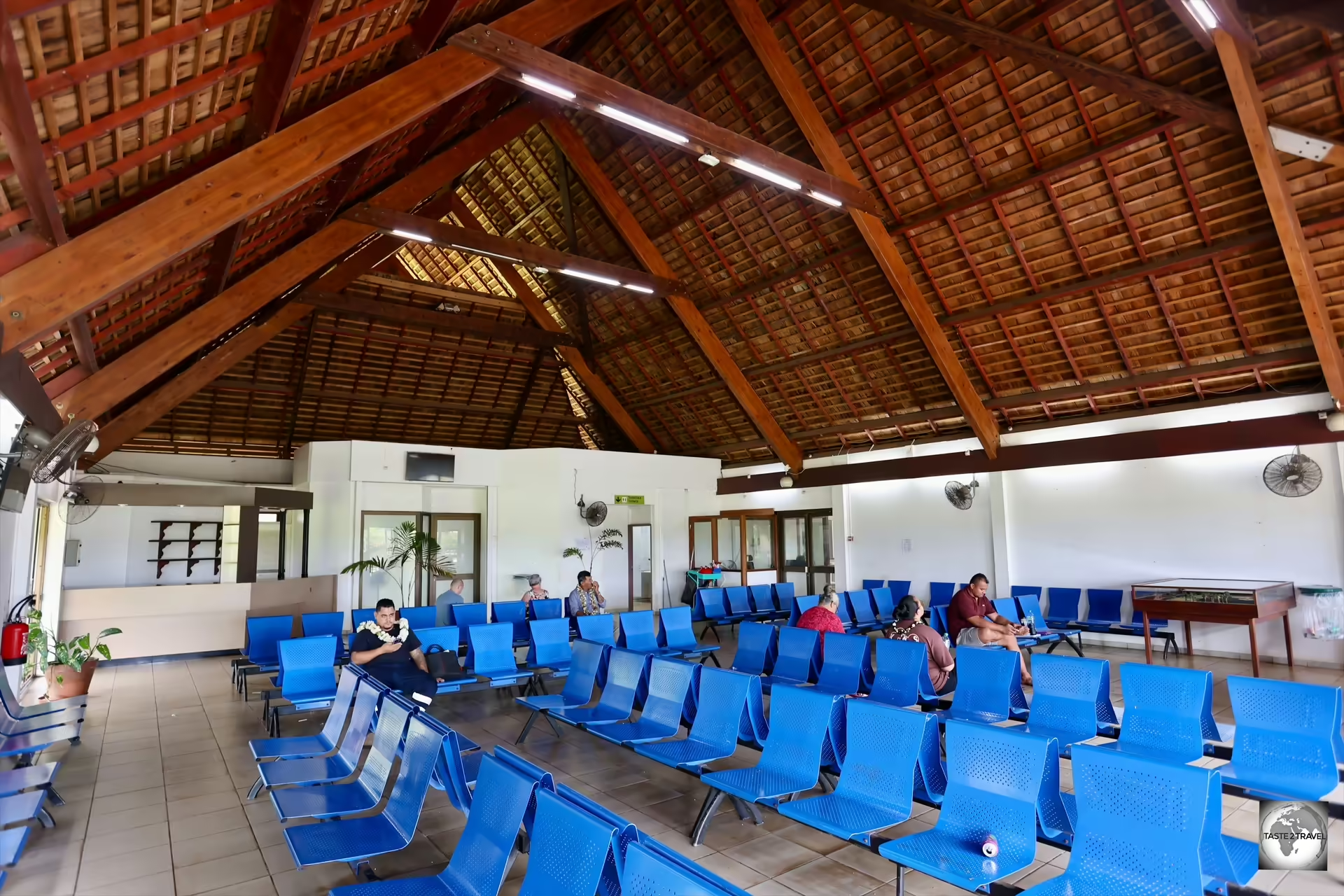
The departure lounge at Wallis Airport.
Airfare comparison – Noumea to Wallis versus Nadi to Wallis
There are 4 different fare types offered by Aircalin between Noumea and Wallis. The following represent the cheapest available (one-way) airfares, on the same day, in each class:
- Economy Saver: between Noumea and Wallis = €322
- Economy Value: between Noumea and Wallis = €359
- Economy Flex: between Noumea and Wallis = €456
- Premium Economy: between Noumea and Wallis = €556
Fares offered by Aircalin between Nadi and Wallis. The following represent the cheapest available (one-way) airfares, on the same day, in each class:
- Economy Saver: between Nadi and Wallis = €240
- Economy Value: between Nadi and Wallis = €283
- Economy Flex: between Nadi and Wallis = €377
- Premium Economy: between Nadi and Wallis = €434

My boarding pass, flying with Aircalin, from Noumea to Wallis Island.
Flight Routings
Each flight operates from Noumea to Wallis with a transit stop at Nadi International Airport (IATA: NAN).
The order of the transit stop in Fiji is switched between the two flights with the Saturday flight stopping at Fiji on the way to Wallis while the Monday flight stops at Fiji after leaving Wallis.
Saturday flight routing:
- (Flight SB330) Noumea – Nadi – Wallis
- (Flight SB331) Wallis – Noumea
Monday flight routing:
- (Flight SB340) Noumea – Wallis
- (Flight SB341) Wallis – Nadi – Noumea
Futuna Island

This single aircraft, operated by Air Loyauté, connects Wallis and Futuna Island twice a day.
Futuna Island lies 234 km (145 mi) southwest of Wallis Island, about halfway between Wallis Island and Fiji.

Futuna Airport ’boutique’.
Pointe Vele Airport (IATA: FUT) is the airport serving Futuna Island. There are no international flights arriving here!

Air Loyauté arriving at Futuna Airport.
Located in the south-east corner of the island, the airport is located 10 kilometres (6 mi) east of Leava, the capital of Futuna.

The waiting area at Futuna Airport.
Air Loyauté, a carrier from New Caledonia, operate twice daily flights between Wallis and Futuna Islands using a small de Havilland Canada DHC-6 Twin Otter with a seating capacity for 12 passengers.

The check-in desk at Futuna Airport.
A return flight between Wallis and Futuna costs 29,800 XPF (EUR €249.80 / USD$277.85).

The office of Wallis Voyages in downtown Mata-Utu.
Tickets, which cannot be booked online, must be booked through Wallis Voyages who can be contacted via email at: wallisvoyages@mail.wf

A copy of my flight ticket from Wallis to Futuna Island.
Flights tend to be booked out weeks in advance so it’s best to book your seat as far in advance as possible.
Your email will most likely be answered by the very helpful Christophe Laurent, who speaks French and English.

Air Loyauté baggage tags from FUT to WLS airport.
Christophe also holds the key to the Wallis Museum and is the man to contact if you wish to arrange a visit to the one-room museum.
Contact details for Christophe:
Airport Transport
There are no taxis or public transport on Wallis and Futuna. You will need to organise an airport transfer with your accommodation provider.
Wallis Island
On Wallis Island, my Airbnb host, Manuel, provided airport transfers at a rate of XPF 1,000/trip (US$9.00).
Futuna Island
On Futuna Island, my hotel, Hotel FiaFia, provided airport transfers for XPF 3,000/ trip (US$27.00).
Sea
No commercial boat company exists in this remote territory, therefore travel between Wallis and Futuna is exclusively by plane.
Getting Around

This sign, which is located directly outside the airport, is one of the few road signs on Wallis Island.
There is no public transport, nor are there any taxis, on either Wallis or Futuna Islands.
The only feasible way to explore the islands, and to maximise your time, is with a rental car.
Wallis Island has about 120 km of roads, much of which are paved. There are no street lights at night and very few road signs, since everyone knows where they are going!
A single coastal ring road circumnavigates the very mountainous Futuna Island.
While you can travel through the interior of Wallis Island, you cannot access the near-vertical interior of Futuna Island (unless you hike).
Rental Car

Exploring Wallis Island in my Toyota Hilux rental car, which I hired through Lausikula guesthouse.
With a complete lack of public transport on the islands, a rental car is the only feasible transport option on Wallis and Futuna.
I organised a rental car through Manuel, the owner of Lausikula guesthouse who charged me XPF 8,000/day (US$72.74) for a trusty Toyota Hilux.
Fuel on the island costs XPF 200 (US$1.82) per litre.
Please refer to the ‘Accommodation‘ section for more details.

All car license plates on Wallis and Futuna are suffixed with ‘WF’.
There are several providers of rental cars on Wallis and Futuna, all of which are listed on the transport page of the Wallis and Futuna Tourism website.
Interestingly, insurance companies do not insure cars on Wallis and Futuna so people drive their cars until they fall apart.
I once passed a car which had obviously rolled at some point. The entire car was smashed and flattened and all windows were broken, but the owner was still able to drive the car and so he did!
That’s the end of my Wallis and Futuna Islands Travel Guide.
If you wish to leave any comments/ feedback, you can do so using the form below.
Safe Travels!
Darren
Further Reading
Following is a list of other travel guides from the Pacific Ocean region:









































































































































































































































































































